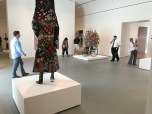Waterfront Toronto
Sherbourne Common is the first park in Canada to integrate a sto…
Infrastructure as art
The notion of “waste” in wastewater is challenged when the energy and nutrients embedded in it are recovered. The same is true when stormwater is considered a resource.
Sherbourne Common exemplifies this philosophy. Opened in 2011, the 3.63-acre park is part of 2,000 acres along Lake Ontario that Waterfront Toronto, a tri-government-funded agency responsible for revitalizing the former industrial area, began redeveloping in 2001.
The area is prone to CSOs during intense wet weather events. The park’s designers were directed to apply the most innovative approaches to sustainable development, urban design, real estate development, and public works to treating the overflows. Their award-winning solution transforms infrastructure into art.
Runoff is collected for initial treatment in underground storage tanks, allowing for sedimentation of suspended solids. The clarified water is then conveyed to an ultraviolet (UV) facility in the basement under a public pavilion, making Sherbourne Common the first Canadian park to incorporate UV into its design for stormwater treatment. The water is then pumped out to the park’s defining visual feature: three tall sculptures from which the flow cascades in veils into a bio-filtration bed. From there it’s directed into a channel that flows into the lake.
Because the water features are open to the public, the design limit was 10 CFU/100 mL of E. coli. Chemical-free UV disinfection inactivates chlorine-resistant organisms like Cryptosporidium and Giardia, which are strictly regulated, and doesn’t produce byproducts that have to be dealt with.
“By combining required municipal infrastructure with excellence in design, architecture, and public art, Sherbourne Common offers a new model for city-builders nationwide and a fabulous year-round destination,” says Waterfront Toronto President and CEO John Campbell.
Complementary colors
In these two examples, gray and green don’t compete but are two options within the same toolbox. Our approach is to evaluate all technologies using sophisticated models and GIS planning techniques to develop optimal solutions that bring the maximum value to communities.
To us, gray and green are complementary colors.
James Schlaman is the integrated planning and green infrastructure practice lead for Black & Veatch’s water business; e-mail schlamanjc@bv.com. Nicholas Sutko is a water resources engineer for Black &Veatch; e-mail sutkonj@bv.com.





